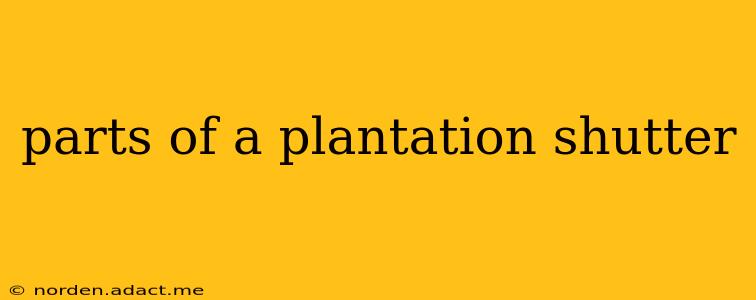Plantation shutters, known for their timeless elegance and light-controlling capabilities, are more than just window coverings. Understanding their component parts is key to appreciating their craftsmanship, choosing the right style, and ensuring proper maintenance. This guide delves into the specifics of plantation shutter construction, answering common questions and providing valuable insights for homeowners and enthusiasts alike.
What are the main parts of a plantation shutter?
The core components of a plantation shutter can be broadly categorized into the frame, the louvers, and the operating mechanism. Let's break down each part in detail:
-
Frame: This is the structural backbone of the shutter, typically constructed from high-quality wood, PVC, or composite materials. The frame provides stability and holds the louvers in place. It's crucial for the overall durability and aesthetic appeal of the shutter. Different frame styles exist, affecting the overall look (e.g., a traditional raised panel frame versus a more modern, minimalist design).
-
Louvers (or Blades): These are the horizontal slats that make up the primary feature of plantation shutters. They are typically wider than those found in traditional blinds, creating a more substantial and elegant appearance. The louvers are responsible for controlling the amount of light and airflow entering the room. Their size and spacing significantly impact the style and functionality of the shutter.
-
Operating Mechanism: This system allows you to adjust the angle of the louvers. The most common type is a tilt rod, which allows you to precisely control light and privacy. Some higher-end shutters may incorporate hidden tilt rods for a cleaner, more streamlined look. Another operating mechanism is the hidden tilt system, where the tilt rod is concealed within the louvers. This design enhances the shutters' sleekness.
What type of wood is used for plantation shutters?
A variety of woods can be used for plantation shutters, each with its own characteristics in terms of durability, cost, and aesthetic appeal. Common choices include:
- Basswood: A popular choice known for its smooth surface, paintability, and affordability.
- Paulownia: A lighter wood option that offers excellent stability and resistance to warping.
- Hardwoods (e.g., Oak, Mahogany): More expensive but offer superior durability and a richer, more luxurious look.
The type of wood used significantly affects the overall cost and lifespan of your plantation shutters. Consider your budget and desired aesthetic when making your selection.
What are the different types of plantation shutters?
Plantation shutters aren't one-size-fits-all. Various types cater to different window styles and preferences:
- Full Height Shutters: These cover the entire window frame, extending from top to bottom.
- Café Style Shutters: These cover only the lower portion of the window, leaving the upper portion unobstructed.
- Tier-on-Tier Shutters: These consist of two separate panels that operate independently, offering greater flexibility in light and privacy control.
- Sliding Shutters: Ideal for wider windows or patio doors, these shutters slide open and closed on a track system.
How are plantation shutters installed?
Installation typically involves mounting the frame directly to the window frame or the wall. The complexity of the installation process varies depending on the type of shutter and window configuration. While DIY installation is possible for some, professional installation is often recommended to ensure a precise and secure fit.
What is the difference between wood and faux wood plantation shutters?
The main differences lie in durability, maintenance, and cost:
- Wood Shutters: Offer a more luxurious look and feel but are susceptible to warping, moisture damage, and require more maintenance.
- Faux Wood Shutters (typically PVC): More resistant to moisture, warping, and fading, requiring less maintenance and often being more budget-friendly.
How do I clean plantation shutters?
Cleaning methods depend on the material:
- Wood Shutters: Dust regularly with a soft cloth or brush. For deeper cleaning, use a damp cloth and mild detergent.
- Faux Wood Shutters: Generally easier to clean; use a damp cloth and mild detergent. Avoid abrasive cleaners.
By understanding these key components and considerations, you can make an informed decision when choosing plantation shutters for your home, ensuring you select the perfect style and material for your needs and budget. Remember to consult with a professional for accurate measurements and installation, particularly for more complex window configurations.
